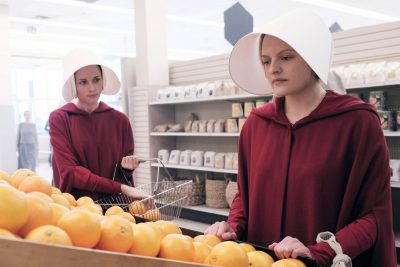
Red shapeless dresses. Life under surveillance. A taxing duty to fulfill.
These are the realities for Offred (Elisabeth Moss) and the other handmaids in Hulu’s newest must-watch show, “The Handmaid’s Tale.”
Based on the 1985 Margaret Atwood novel, the show takes viewers to Gilead, a dystopian future society where fertile women must bear children for the elite men and their barren wives after a fertility crisis left the population in danger.
For those who have read Atwood’s novel, the show serves as a far superior visual adaptation of the dystopian nightmare than the disappointing 1990 film version.
For those who have not, absorbing the show is like free falling into an eerily plausible future when women’s rights have been completely stripped away.
The show is utterly terrifying and relevant for its timely connection present concerns over the mistreatment of women. Its first episode was released on Wednesday, just before President Donald Trump’s 100th day in office.
Aside from its political relevance, the Hulu series stays true to the novel, which can be attributed to Atwood’s role as consulting producer on the show.
Much of the script comes directly from the book, utilizing voiceovers to establish Offred’s exposition and the flashback-heavy structure of the novel.
Moss, best known for playing Peggy in “Mad Men,” has taken on yet another role that places as a woman navigating a male-dominated world.
She gracefully captures Offred’s complexities and acutely portrays the sensation of being trapped between remembering her past and striving for the future. She even manages to execute the dark humor of the character.
Her shopping partner, Ofglen, is played by Alexis Bledel. Unlike Moss, Bledel’s performance started out rocky but improved as the pilot continued.
The show is wrought with flashbacks to Offred’s life before she was Offred, at a time that looks much like our present day.
These are pinnacle moments, when the audience can see how life in a Northeastern city can slowly become the harsh reality of Gilead right under everyone’s noses.
The audience realizes the plausibility and relevance of “The Handmaid’s Tale” during a series of deviations from present-day Gilead.
During these scenes, Offred is shown as her old self, June, when she kept the company of Luke (O-T Fagbenle), Hannah (Jordana Blake) and her best friend Moira (Samira Wiley).
Moira is the epitome of modern feminism and is not afraid to speak her mind, but Wiley masterfully captures the internalization of those ideals to stay safe when she ends up a handmaid with Offred.
The first of the three episodes released Wednesday opened with a high-stress chase scene in which Offred, Luke and Hannah attempt to escape radical totalitarians by crossing the border into Canada.
Although the novel does not open with this scene, it was a smart choice for the Hulu series. It is captivating and prepares the audience for the constant state of anxiety and fear in which the handmaids live.
These feelings come from living under constant surveillance, be it from armed government officials or stern wives.
Yvonne Strahovski plays Serena Joy, the commander’s wife. She brilliantly captures the inner pain of a high-class woman with very little control over her life.
The costuming plays an extremely important role in “The Handmaid’s Tale” and the costume designer, Ane Crabtree, hits this nail on the head.
Class is symbolized through color in Gilead. Handmaids are always dressed in red, the color of menstruation and birth, and white bonnets, the color of purity. Wives are dressed in blue and Marthas, the servants, in green. Commanders wear black, a powerful color.
The cinematography is also well done. The most memorable moments are aerial shots of groups of handmaids. Only the red of their cloaks and white of their bonnets can be seen, so they all look the same. It serves as a powerful symbol of how they are not treated as real humans but rather wombs in which they can create children for the rich.
Although the story is over 30 years old, Offred’s tale has found relevance in today. The Hulu series is a wonderful, though frightening, visualization of Atwood’s novel.
The first three episodes of the series are streaming now on Hulu, with weekly episode releases to follow.





















































































































